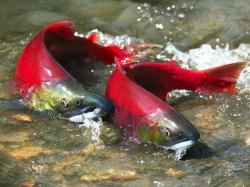Wild Alaska Salmon Earns New Responsible Fisheries Certification
March 21, 2011 | 3 min to read

Juneau, Alaska – Alaska Salmon is the first of Alaska’s major commercial fisheries to be awarded the independent, third-party Responsible Fisheries Management Certification. This certification is based on the United Nations Food and Agriculture Organization (FAO) Code of Conduct for Responsible Fisheries and the FAO Guidelines for Ecolabelling of Fish and Fishery Products from Marine Capture Fisheries. The certification includes all Pacific salmon species caught in Alaska: king, sockeye, coho, keta, and pink.
Alaska is one of the largest suppliers of wild-caught seafood in the world, and has long been regarded as a global model for successful fisheries management. In recent years, the marketplace has called for more documentation and proof regarding sustainability. To meet that market demand and provide additional verification and assurance, the Alaska Seafood Marketing Institute (ASMI) retained an independent third-party sustainability certifier, Global Trust Ltd., to review and assess Alaska’s wild commercial fisheries directly against the FAO Code in 2010. On March 11, 2011 Global Trust certified the first Alaska fishery (Salmon) for responsible fisheries management. ASMI has submitted applications for Alaska’s other major commercial fisheries (Halibut, Black cod, King and Snow crab, and Alaska Pollock), which are in process.
“Alaska has been managing fisheries on the sustained yield principle since 1959, when Alaska became a State and wrote sustainability into its Constitution, so we’ve been living up to the FAO standards for a long time. We are very excited to make this new tool available to Alaska seafood customers, which offers a tangible certification that meets the highest benchmarks, conforming directly to FAO code and guidelines. This certification is intended to provide a respected and credible alternative to other eco-label programs currently available, and provide additional assurance to buyers, markets, and stakeholders,” notes ASMI’s Executive Director, Ray Riutta.
Because the certification is being provided through ASMI, there will be no logo licensing fees. The certification will help to enhance the Alaska origin as a leading source of sustainable responsibly managed seafood. This program is separate from and does not impact other logo schemes.
To download a copy of the Alaska Salmon Responsible Fisheries Management Certification Summary please visit: http://sustainability.alaskaseafood.org/salmon-certification. The Full Assessment and Certification Report (250 pages) will be available on April 1, 2011 at http://sustainability.alaskaseafood.org/salmon-certification and www.gtcert.com.
For More Information
Throughout the certification process, ASMI is posting information on the progress of each fishery http://sustainability.alaskaseafood.org/certification. You can also sign up to receive periodic email updates from ASMI to help you monitor the certification process and stay abreast of latest developments and news. To sign up, visit: http://sustainability.alaskaseafood.org/ e-blasts-sign-up.
About Alaska Salmon
Alaska is home to over 90% of the wild salmon in North America, and five different species: king, sockeye, coho, keta, and pink. The Alaska Department of Fish & Game projects a science based sustainable harvest of 203 million salmon in the upcoming 2011 Alaska summer salmon season. Salmon is a top favorite among consumers. Alaska salmon is a versatile, and comes in a variety of product forms and price ranges. Fin-fish farming is illegal in Alaska, therefore all salmon from Alaska are wild.
Boston International Seafood Show 2011
ASMI will host a seminar on the Alaska FAO-Based Fishery Certification on March 21st, 10am – noon, in room #252B at the Boston Convention and Exhibition Center. The seminar will feature special guest speaker Dr. Grimur Valdimarsson (formerly Director of Fish Products and Industry at the FAO). RSVP here
About Alaska Seafood
For more than 50 years, Alaska has been dedicated to sustainable seafood. It’s so essential to our way of life that our Constitution has a mandate that “fish … be utilized, developed and maintained on the sustained yield principle.”
The seafood industry is Alaska’s largest private sector employer. As a result, Alaskans understand the need to protect the fisheries and surrounding habitats for future generations. We’re proud of our leadership in sustainable management, which has led to an ever-replenishing supply of wild seafood for markets around the world. www.alaskaseafood.org
Source: Alaska Seafood Marketing Institute
